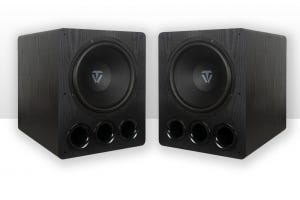
Typically, most people consider the speakers to be the most important part of a sound system, and the only part worthy of spending hours to choose the right ones. What most don't realize is that the amplifier is just as important in terms of sound quality and getting the most out of your speakers. Or, perhaps more importantly, that the wrong amplifier can damage or destroy your speakers. And it's not just about having the best amplifier, it's about having an amp that is fully compatible with your speakers.
So, how do you determine if your amp and speakers are compatible? Unfortunately, the answer is not so simple. In fact, even experts have differing opinions on which device pairings are acceptable. But for the casual listener, getting the perfect match is not as important as simply not frying your equipment, and for that you only need to know the basics. Compatibility is dependent on three key features of the devices: power, impedance, and sensitivity. We'll go over each of these parameters and how to use them to find an amplifier that is compatible with your speakers.
Power
Power refers to the wattage output of an amplifier and the wattage intake of a speaker. In other words, it is a measure of how much power an amplifier can deliver, and how much power a speaker requires or can handle without being damaged. The biggest misconception about power is that more watts means higher volume -- this is not the case.
The bottom line when it comes to power is that you need an amplifier with a power output that matches or is no more than four times greater than the speaker power requirements. In other words, you want to avoid under-powering your speakers (although, if you over-power them an extreme amount you can damage them, but this is not easy to do). An amp with a low power rating will not produce audio at a full volume without clipping. Clipping refers to a distortion of the audio wave, and is most commonly the cause of damaged speakers.
Amplifiers are often rated for Continuous Power and Dynamic (Peak) Power. Continuous Power refers to the wattage an amplifier can deliver continuously; this is the most important spec because it describes how the amp functions during normal operation. Dynamic Power is the maximum wattage output of an amp during the dynamic frequencies that occur during most audio signals like music. In other words, an amp with a CP rating of 100 watts will generally be delivering 100 watts of power, but it might deliver 150 or 200 watts very briefly -- that's Dynamic Power. The range between Continuous and Dynamic power ratings is called 'headroom'. Generally speaking, the more headroom an amp has, the lower your risk of clipping.
Power specifications on speakers are a bit more complicated, as different brands have their own ways of specifying power capabilities. Some brands will use Maximum Continuous Power, Minimum Recommended Power, or Maximum Short-Term Peak Power ratings. Others will simply list the recommended amplification power range. Compare the speaker and amp power specs to ensure your amp will deliver enough continuous power to the speakers to avoid clipping.
Impedance
Impedance is a measurement of electrical resistance, usually measured in ohms (Ω). Don't worry, you don't have to know what electrical resistance is to compare impedance specs. The biggest rule is to make sure your amplifier impedance is below your speaker impedance, otherwise you can damage your amp.
Although impedance is important, it likely will not be an issue, as most consumer speakers these days are rated at six to eight ohms. However, it's helpful to understand that amplifiers will deliver more power into a lower ohm rating. For example, an amp that is rated to deliver 180 watts of power into an 8 ohm load may be rated to deliver 265 watts into a 4 ohm load. So if your amp has an impedance rating much lower than that of your speakers, it's going to deliver much less power. It's usually best to match the impedance ratings as close as possible.
Sensitivity
This specification only applies to speakers. Speaker sensitivity refers to the measure of volume in decibels a speaker produces from 1 metre away when fed 1 watt of power. Sensitivity does not necessarily correlate with speaker quality, it just determines how much power the speaker requires to reach certain volumes. The interesting thing about sensitivity is that in order to increase the volume by 3 dB, you'll need to double the amplification power. The required power increases exponentially compared to volume level, and volume decreases significantly as you increase the distance from the speaker, which is why amplifiers have such high wattage outputs.
Take a look at the sensitivity rating of your speakers to determine how effectively an amplifier will drive them. If you know you want to listen to your music at a certain volume, you can do some quick math to determine the minimum power rating your amp will need. In general, if you want to be able to play louder volumes, getting an amp with more power than what your speakers require is a safe choice.
If you take those three specifications into consideration when choosing an amp, you can ensure that you're not going to damage any of your equipment and you'll be able to fully experience your hi-fi speakers. If you find all these numbers and ratings to be confusing, you can always ask a manufacturer or audio experts here at Selby for advice on which amp will work with your speakers. Choosing an amp by the same brand as your speakers is also a great start to ensuring that the devices will work well together.





